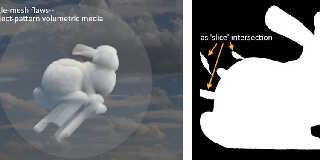|
 |
"Bald Eagle" <cre### [at] netscape net> wrote:
>
> One thing I thought of is: if you use the object pattern, then you can just
> slide or scale or reproportion a box that's pigmented with the object pattern,
> and you'll get a nice image without having to do any "slicing" by differencing
> an actual slice.
Ah yes! I had forgotten about that. My past use of the object pattern was
exclusively for creating *volumetric* media; but of course, it can be used as
you mention, by having a thin surface intersect it, then simply moving the
surface through the object-pattern's volume.
Alas, none of my old bicubic-patch objects even show up when given the
object-pattern treatment; they are ignored by the pattern. Which is no worse
than my present situation with those objects! (I have since learned NOT to use
them in POV-ray-- even though they render OK *as* objects in a typical scene.)
But the object pattern also has the interesting(?) ability to show flaws in
triangle-mesh objects-- like holes, or an un-closed mesh-- that otherwise don't
show up in a typical render. I discovered this by accident during some old media
experiments. (The image below illustrates this.) The bunny model renders fine as
a typical object; but when used as an object pattern, the holes(?) in the bottom
are picked up and proudly displayed! The direction of those errant rays is the
same as the bunny mesh's inside_vector direction.
But my 'image slicing' technique (with the intersected box) fares no better-- it
*also* picks up such mesh flaws, for reasons unknown. This is apparently an
unexpected(?) result of the simple intersection process itself. Obviously, any
mesh object used in my 'slice' technique needs to be free of flaws.
>
> > ..in Cura printer software--
> > it has to be scaled down to fit even my printer's max volume-- which has the
> > excellent effect of reducing the size of the triangles in the .stl triangle
> > mesh, greatly improving the printed quality.
>
> And there, my friend, you have just discovered a way to make a mesh from
> a bunch of primitives.
> Get your slices, make your model, export an ASCII stl file, and then
> convert it to a mesh {}.
>
A great idea! (Although, I don't know the intricacies or re-coding strategy for
the .stl --> mesh conversion; I think you mentioned elsewhere that you came up
with such a process in the past?)
Oh, and unfortunately, the '3D slicer' app outputs its .stl file in only the
binary format; no choice of an ASCII version there :-( So far, anyway... but
the developers are always adding new features to the app, from user feedback... net> wrote:
>
> One thing I thought of is: if you use the object pattern, then you can just
> slide or scale or reproportion a box that's pigmented with the object pattern,
> and you'll get a nice image without having to do any "slicing" by differencing
> an actual slice.
Ah yes! I had forgotten about that. My past use of the object pattern was
exclusively for creating *volumetric* media; but of course, it can be used as
you mention, by having a thin surface intersect it, then simply moving the
surface through the object-pattern's volume.
Alas, none of my old bicubic-patch objects even show up when given the
object-pattern treatment; they are ignored by the pattern. Which is no worse
than my present situation with those objects! (I have since learned NOT to use
them in POV-ray-- even though they render OK *as* objects in a typical scene.)
But the object pattern also has the interesting(?) ability to show flaws in
triangle-mesh objects-- like holes, or an un-closed mesh-- that otherwise don't
show up in a typical render. I discovered this by accident during some old media
experiments. (The image below illustrates this.) The bunny model renders fine as
a typical object; but when used as an object pattern, the holes(?) in the bottom
are picked up and proudly displayed! The direction of those errant rays is the
same as the bunny mesh's inside_vector direction.
But my 'image slicing' technique (with the intersected box) fares no better-- it
*also* picks up such mesh flaws, for reasons unknown. This is apparently an
unexpected(?) result of the simple intersection process itself. Obviously, any
mesh object used in my 'slice' technique needs to be free of flaws.
>
> > ..in Cura printer software--
> > it has to be scaled down to fit even my printer's max volume-- which has the
> > excellent effect of reducing the size of the triangles in the .stl triangle
> > mesh, greatly improving the printed quality.
>
> And there, my friend, you have just discovered a way to make a mesh from
> a bunch of primitives.
> Get your slices, make your model, export an ASCII stl file, and then
> convert it to a mesh {}.
>
A great idea! (Although, I don't know the intricacies or re-coding strategy for
the .stl --> mesh conversion; I think you mentioned elsewhere that you came up
with such a process in the past?)
Oh, and unfortunately, the '3D slicer' app outputs its .stl file in only the
binary format; no choice of an ASCII version there :-( So far, anyway... but
the developers are always adding new features to the app, from user feedback...
Post a reply to this message
Attachments:
Download 'triangle_mesh_oddities_kw.jpg' (34 KB)
Preview of image 'triangle_mesh_oddities_kw.jpg'

|
 |




![]()